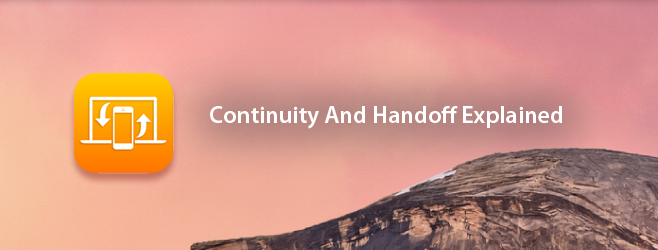Seamless Integration With Continuity And Handoff Explained [OS X]
News of Yosemite came out at Apple’s WWDC. After an age, software was the sole focus of the update. There was Swift programming language, iOS 8, OS X Yosemite, and our sole focus lied in that spectrum. There was mention of another feature, that we didn’t know we needed this badly, was continuity/handoff. The terms alone do not sufficiently express the range of capabilities it brings, let us walk you through exactly how this will benefit you and how you can use these incredible new features.
The biggest problem faced by hordes of techies is the inability to seamlessly port features, not without outside help at least. You would have to save a draft to your inbox, then open it on another device to continue working on it from there on out. That and tab sharing. Fortunately, Apple exercised foresight and expanded into a completely different realm of sharing.
The underlying technology is an expansion of Airdrop, which now works across all platforms, be it iOS or OS X (that in itself is pretty big news). Now, instead of just being able to share files, you can also share entire features. At this stage in development, these features are only capable of handing apps from iOS to OS X, the final builds are promised to support two-way handoffs between platforms. You will be able to receive handoffs as icons appearing on your lockscreen.
WiFi Hotpot
A feature that had been sorely missing in iOS was the inherent capability of using your iOS device’s data as a WiFi hotspot, allowing your Mac to connect to the internet without WiFi access. This could have been achieved with third-party software, but native support offers easier access. More importantly, it finally brings a long yearned android feature to iOS.
iCloud Drive
With cloud storage being all the rave and iCloud serving as mere backup service, Apple has finally decided to let users access its storage as they would any other service like Dropbox, Box, OneDrive, etc. Now you can directly access files stored by one device, eliminating a large chunk of third party synchronization apps, again, native is almost always better. Internet Explorer serving as example of an exception. iCloud retains its former utility in terms of saving backups, settings, features, app lists, purchased items, etc. with the added support of Drive utility. We definitely look forward to exploring hidden tips and secrets when the final build releases.
Handoff
Handoff is a feature that, when activated, will sync any iOS or Mac with another using the same Apple ID via bluetooth. As long as the bluetooth is turned on and the two devices are nearby, the Handoff feature activates. Your Mac enters a low power, ‘listening’ mode for any incoming connections. Its default behaviour is the same across the board. When an app launches on an iOS device, it will show up as a shortcut on the Dock. This feature is only available from iOS to OS X for now, the final build promises vice versa, but we don’t yet know exactly that works, but we know it will. We’ll keep you posted. Each app shows up uniquely on Handoff, here is how.
Emails + Supported Apps
If you are writing an email on your iOS device and decide that you could use a keyboard for this particular endeavour, simply click on the email icon in Dock and it will pick up exactly where you left off, not a spacebar out of place. Plain and simple. Similar results were found with all supported apps, including Pages, Numbers, Keynote, Messages (SMS directly from your Mac), Reminders, Calendar, and Contacts.
Phone Calls
We have gone over the (pardon the crude phrasing) sheer awesomeness of this feature before, you now have the ability to take phone calls on your computer, and if apps like Handsfree are any indicator, the sound quality will be unlike anything you have ever heard over the phone. So, ideally, you could just end up not having to interact with your phone at all if calls are a priority.
Maps
If you browse the Maps app on your iOS device and focus on a region. Clicking on its icon in the Dock will show you exactly that region. Since you will have handed it off, you will need to do the whole thing all over again in order to display a new location. We don’t know if future builds promise realtime updates or will this be as finished as it is. Either way, it serves its purpose.
Safari
Now, Safari behaves in a manner familiar to CloudTabs, with the only difference being that it now also appears in the dock. Any site you are visiting will show up in Safari’s Top Sites tab, that will take you directly to the page you were accessing on your iOS device. It will not take you to the exact position on the page though, we don’t know if that will be addressed in future builds, but that is figuratively nitpicking, which, unless it is a poorly designed site with enormous content, won’t be an issue.
Conclusion
Handoff is a very promising feature and it will most certainly recall some wayward Apple users. Nothing brings in users like uniform architecture. Also, this feature is not going to be limited to apps created by Apple either, APIs are being sent to developers to help integrate Handoff with their own apps as well. We could theoretically, transfer games, apps, edited images, off between devices. This is the next step in uniform integration throughout Apple devices and we are certainly excited. More, as it (literally) develops.

